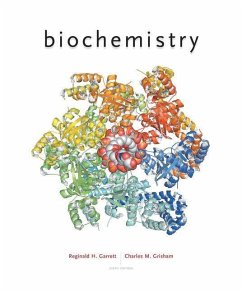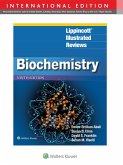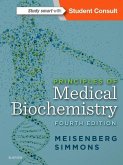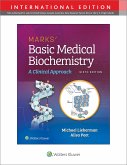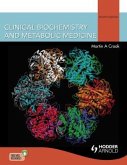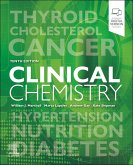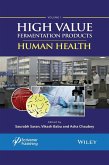- Gebundenes Buch
- Merkliste
- Auf die Merkliste
- Bewerten Bewerten
- Teilen
- Produkt teilen
- Produkterinnerung
- Produkterinnerung
Succeed in the course with BIOCHEMISTRY. The authors' innovative conceptual and organizing "Essential Questions" framework guides you through course concepts in a way that reveals the beauty and usefulness of biochemistry in the everyday world. Offering a balanced and streamlined presentation, this edition has been updated throughout with new material and revised presentations. This book is integrated with OWLv2, a powerful online learning system for chemistry with book-specific end-of-chapter material that will help you improve your grades and master course concepts.
Andere Kunden interessierten sich auch für
![I Domains in Integrins I Domains in Integrins]() Donald Gullberg (Hrsg.)I Domains in Integrins115,99 €
Donald Gullberg (Hrsg.)I Domains in Integrins115,99 €![Lippincott® Illustrated Reviews: Biochemistry Lippincott® Illustrated Reviews: Biochemistry]() Emine Ercikan AbaliLippincott® Illustrated Reviews: Biochemistry40,99 €
Emine Ercikan AbaliLippincott® Illustrated Reviews: Biochemistry40,99 €![Principles of Medical Biochemistry Principles of Medical Biochemistry]() Gerhard Meisenberg (Ross Univ Course Director Medical BiochemistryPrinciples of Medical Biochemistry74,99 €
Gerhard Meisenberg (Ross Univ Course Director Medical BiochemistryPrinciples of Medical Biochemistry74,99 €![Marks' Basic Medical Biochemistry Marks' Basic Medical Biochemistry]() Lieberman, Michael A., PhDMarks' Basic Medical Biochemistry55,99 €
Lieberman, Michael A., PhDMarks' Basic Medical Biochemistry55,99 €![Clinical Biochemistry and Metabolic Medicine Clinical Biochemistry and Metabolic Medicine]() Martin CrookClinical Biochemistry and Metabolic Medicine73,99 €
Martin CrookClinical Biochemistry and Metabolic Medicine73,99 €![Clinical Chemistry Clinical Chemistry]() Marshall, William J., MA, PhD, MSc, MBBS, FRCP, FRCPath, FRCPEdin, FClinical Chemistry47,99 €
Marshall, William J., MA, PhD, MSc, MBBS, FRCP, FRCPath, FRCPEdin, FClinical Chemistry47,99 €![High Value Fermentation Products, Volume 1 High Value Fermentation Products, Volume 1]() High Value Fermentation Products, Volume 1238,99 €
High Value Fermentation Products, Volume 1238,99 €-
-
-
Succeed in the course with BIOCHEMISTRY. The authors' innovative conceptual and organizing "Essential Questions" framework guides you through course concepts in a way that reveals the beauty and usefulness of biochemistry in the everyday world. Offering a balanced and streamlined presentation, this edition has been updated throughout with new material and revised presentations. This book is integrated with OWLv2, a powerful online learning system for chemistry with book-specific end-of-chapter material that will help you improve your grades and master course concepts.
Produktdetails
- Produktdetails
- Verlag: Brooks/Cole / Cengage Learning EMEA
- 6. Aufl.
- Seitenzahl: 1280
- Erscheinungstermin: 16. Februar 2016
- Englisch
- Abmessung: 282mm x 235mm x 55mm
- Gewicht: 2722g
- ISBN-13: 9781305577206
- ISBN-10: 1305577205
- Artikelnr.: 43603909
- Herstellerkennzeichnung
- Libri GmbH
- Europaallee 1
- 36244 Bad Hersfeld
- gpsr@libri.de
- Verlag: Brooks/Cole / Cengage Learning EMEA
- 6. Aufl.
- Seitenzahl: 1280
- Erscheinungstermin: 16. Februar 2016
- Englisch
- Abmessung: 282mm x 235mm x 55mm
- Gewicht: 2722g
- ISBN-13: 9781305577206
- ISBN-10: 1305577205
- Artikelnr.: 43603909
- Herstellerkennzeichnung
- Libri GmbH
- Europaallee 1
- 36244 Bad Hersfeld
- gpsr@libri.de
Reginald H. Garrett was educated in the Baltimore city public schools and at the Johns Hopkins University, where he received his Ph.D. in biology in 1968. Since that time, he has conducted research and taught biochemistry courses at the University of Virginia, where he is currently Professor of Biology. He is the author of numerous papers and review articles on biochemical, genetic, and molecular biological aspects of inorganic nitrogen metabolism. His early research focused on the pathway of nitrate assimilation in filamentous fungi. His investigations contributed substantially to our understanding of the enzymology, genetics, and regulation of this major pathway of biological nitrogen acquisition. More recently, he has collaborated in systems approaches to the metabolic basis of nutrition-related diseases. His research has been supported by grants from the National Institutes of Health, the National Science Foundation, and private industry. A member of the American Society for Biochemistry and Molecular Biology, Garrett is a former Fulbright Scholar, was twice Visiting Scholar at the University of Cambridge, and was Invited Professor at the University of Toulouse, France.
Part I: Molecular Components of Cells 1. The Facts of Life: Chemistry Is the Logic of Biological Phenomena 2. Water: The Medium of Life3. Thermodynamics of Biological Systems4. Amino Acids and the Peptide Bond5. Proteins: Their Primary Structure and Biological Functions6. Proteins: Secondary, Tertiary, and Quaternary Structure7. Carbohydrates and the Glycoconjugates of Cell Surfaces8. Lipids 9. Membranes and Membrane Transport10. Nucleotides and Nucleic Acids11. Structure of Nucleic Acids12. Recombinant DNA, Cloning, Chimeric Genes, and Synthetic BiologyPart II: Protein Dynamics13. Enzymes-Kinetics and Specificity14. Mechanisms of Enzyme Action15. Enzyme Regulation16. Molecular MotorsPart III: Metabolism and Its Regulation17. Metabolism: An Overview18. Glycolysis19. The Tricarboxylic Acid Cycle20. Electron Transport and Oxidative Phosphorylation21. Photosynthesis22. Gluconeogenesis, Glycogen Metabolism, and the Pentose Phosphate Pathway23. Fatty Acid Catabolism24. Lipid Biosynthesis25. Nitrogen Acquisition and Amino Acid Metabolism26. Synthesis and Degradation of Nucleotides27. Metabolic Integration and Organ SpecializationPart IV: Information Transfer28. DNA Metabolism: Replication, Recombination, and Repair29. T ranscription and the Regulation of Gene Expression30. Protein Synthesis31. Completing the Protein Life Cycle: Folding, Processing, and Degradation32. The Reception and Transmission of Extracellular InformationAbbreviated Answers to ProblemsIndex
Part I: Molecular Components of Cells 1. The Facts of Life: Chemistry Is the Logic of Biological Phenomena 2. Water: The Medium of Life3. Thermodynamics of Biological Systems4. Amino Acids and the Peptide Bond5. Proteins: Their Primary Structure and Biological Functions6. Proteins: Secondary, Tertiary, and Quaternary Structure7. Carbohydrates and the Glycoconjugates of Cell Surfaces8. Lipids 9. Membranes and Membrane Transport10. Nucleotides and Nucleic Acids11. Structure of Nucleic Acids12. Recombinant DNA, Cloning, Chimeric Genes, and Synthetic BiologyPart II: Protein Dynamics13. Enzymes-Kinetics and Specificity14. Mechanisms of Enzyme Action15. Enzyme Regulation16. Molecular MotorsPart III: Metabolism and Its Regulation17. Metabolism: An Overview18. Glycolysis19. The Tricarboxylic Acid Cycle20. Electron Transport and Oxidative Phosphorylation21. Photosynthesis22. Gluconeogenesis, Glycogen Metabolism, and the Pentose Phosphate Pathway23. Fatty Acid Catabolism24. Lipid Biosynthesis25. Nitrogen Acquisition and Amino Acid Metabolism26. Synthesis and Degradation of Nucleotides27. Metabolic Integration and Organ SpecializationPart IV: Information Transfer28. DNA Metabolism: Replication, Recombination, and Repair29. T ranscription and the Regulation of Gene Expression30. Protein Synthesis31. Completing the Protein Life Cycle: Folding, Processing, and Degradation32. The Reception and Transmission of Extracellular InformationAbbreviated Answers to ProblemsIndex

